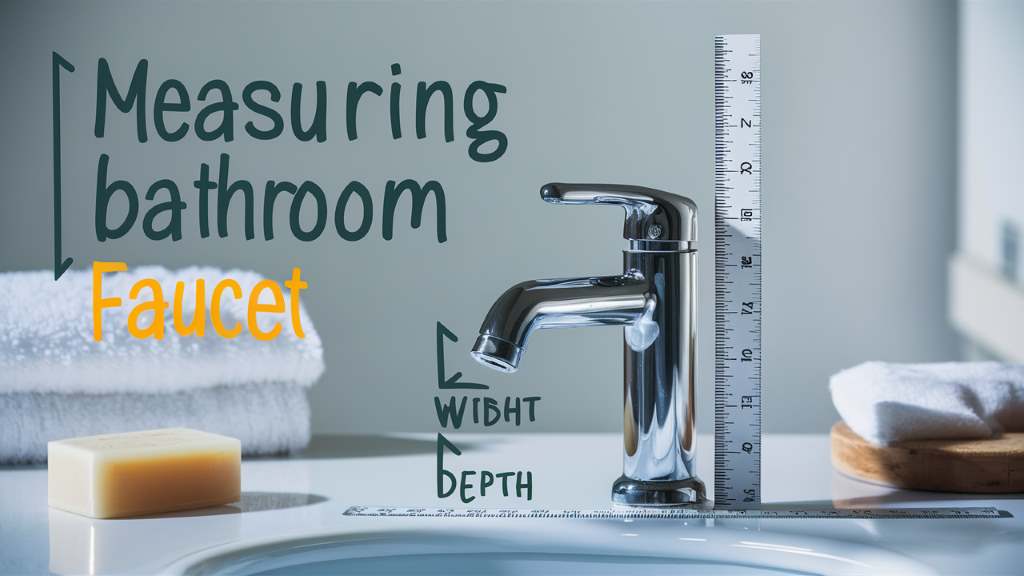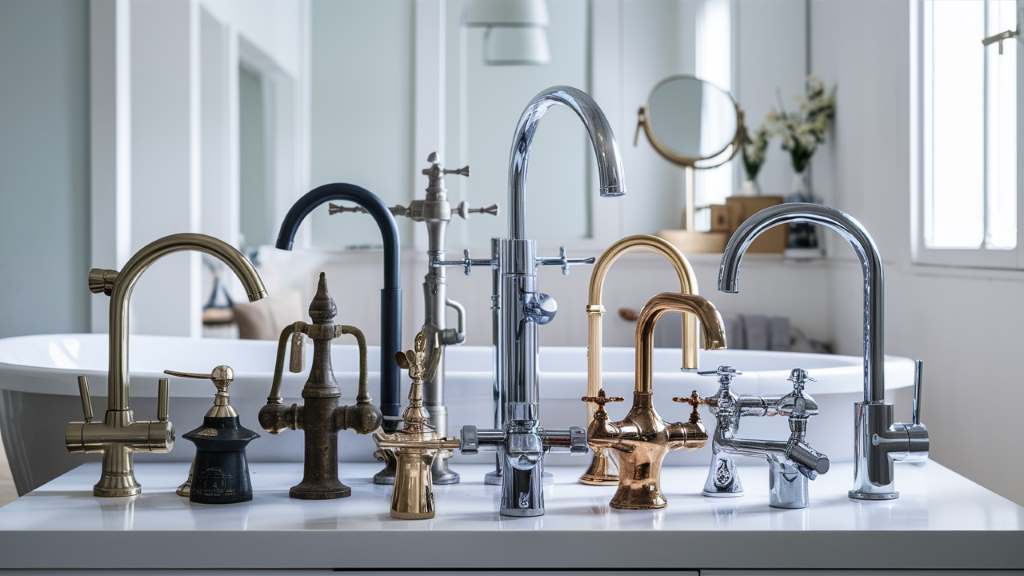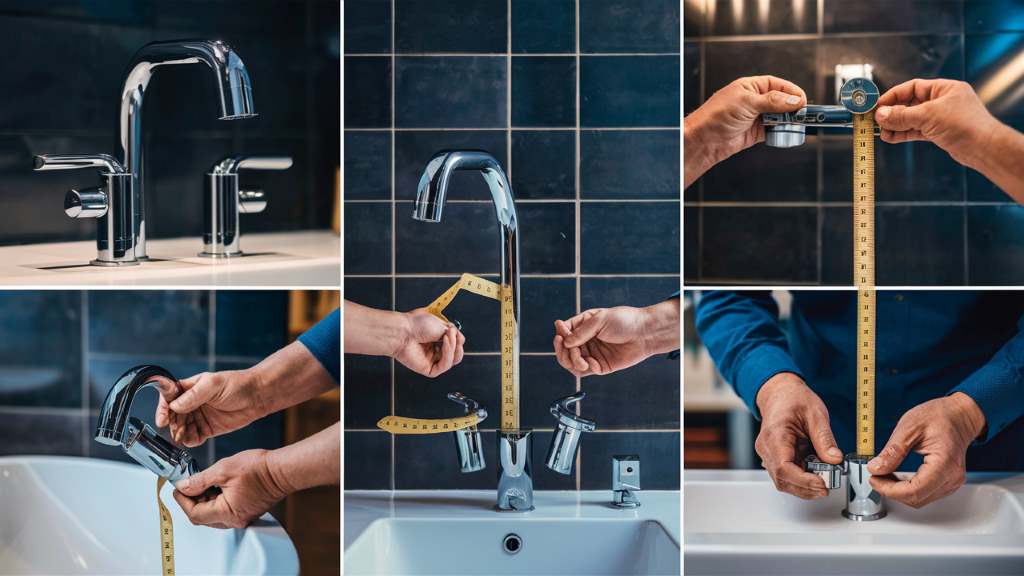Replacing or upgrading a bathroom faucet might seem like a straightforward task, but getting the right measurements is crucial to ensure a seamless installation. Faucets come in various shapes and sizes, and not all will fit the pre-drilled holes in your sink or vanity. Moreover, the wrong measure of the bathroom faucet can lead to issues such as leaks or misalignment with the water supply lines. This article will help you understand how to measure bathroom faucet to avoid these pitfalls and make informed purchasing decisions. Whether you’re working on a renovation or simple maintenance, precise measurements will ensure a perfect fit.
Understanding the Basics: Faucet Types
Before diving into measurements, it’s essential to identify the type of bathroom faucet you have. Faucets typically come in different styles, each with specific installation requirements.
1. Single-Hole Faucets
Single-hole faucets require just one hole for installation. They are typically found in modern sinks with a clean, minimalist look. These faucets combine the spout and handle in one unit, making them ideal for small spaces.
2. Centerset Faucets
Centerset faucets feature two handles for hot and cold water that are connected by a base. They are designed for sinks with three pre-drilled holes and have a compact footprint, with handles and spout all within 4 inches of each other.
3. Widespread Faucets
Widespread faucets consist of separate handles for hot and cold water, along with a spout. They are used for sinks with three holes, but unlike centerset models, the handles and spout are spread out more, typically with a 6-16 inch range.
4. Wall-Mounted Faucets
These faucets are installed on the wall instead of the sink or countertop. They are ideal for vessel sinks and require separate plumbing configurations, as the water supply needs to come through the wall.
Why Measuring a Bathroom Faucet is Important
Getting accurate measurements for your bathroom faucet is essential to avoid issues during installation. If the faucet does not align with the pre-existing holes in the sink, you may face challenges with leaks, improper connections, and aesthetic concerns. Additionally, understanding your faucet dimensions ensures compatibility with your bathroom’s overall layout and decor.
Tools You’ll Need for Measuring a Bathroom Faucet
- Measuring tape or ruler
- Adjustable wrench
- Pen and notepad
- Flashlight (for hard-to-see spaces)
By having these tools on hand, you’ll be ready to measure the faucet efficiently and ensure no mistakes are made.
Step-by-Step Guide on How to Measure a Bathroom Faucet
Measuring the Hole Spacing (Center-to-Center Measurement)
The first and most critical measurement for bathroom faucets is the distance between the faucet’s mounting holes. This is particularly important for centerset and widespread faucets.
- Locate the Mounting Holes: These are the holes on the sink or vanity where the faucet is attached. For a three-hole configuration, this includes the holes for the hot and cold handles and the central hole for the spout.
- Measure the Distance Between Holes: Use your measuring tape or ruler to determine the center-to-center distance between the two outermost holes. For centerset faucets, this distance is typically 4 inches, while for widespread faucets, it can range between 6 to 16 inches.
Measuring the Spout Reach
The spout reach refers to how far the faucet’s spout extends over the sink. This measurement is crucial to ensure water flows directly into the sink basin, avoiding splashing or inefficient use.
- Locate the Spout Base: Start measuring from the center of the spout’s base where it attaches to the sink.
- Measure to the Spout Tip: Extend the tape measure to the end of the spout, where the water exits. This gives you the spout reach. For bathroom sinks, the ideal reach typically ranges between 4 to 8 inches.
Measuring the Spout Height
Spout height refers to the vertical distance between the base of the faucet and the highest point of the spout. This is particularly important if you have a vessel sink or a deep basin.
- Measure from the Base to the Highest Point: Use your tape measure to calculate the distance from the countertop to the highest point on the faucet. This height can vary greatly, especially in modern or designer faucets.
- Consider Sink Depth: If your sink is shallow, a taller spout could cause splashing. Conversely, a deeper sink may benefit from a higher spout for ease of use.
Measuring the Handle Clearance
Handle clearance is the amount of space required for the handles to operate without obstruction. This is an often overlooked but essential measurement to ensure you can comfortably turn the water on and off.
- Measure the Handle Length: If your faucet has separate handles, measure the length of the handles from their base to the tip.
- Check for Obstructions: Ensure that no walls, mirrors, or backsplashes will block the handle movement. Measure the distance between the handle and any potential obstruction to guarantee enough space.
Measuring Wall-Mounted Faucets
For wall-mounted faucets, measuring requires additional steps since they do not sit directly on the sink.
- Measure the Center-to-Center Distance from the Wall: Measure the distance between the faucet’s base on the wall and the spot where the spout exits.
- Check for Waterline Compatibility: Wall-mounted faucets need the water supply lines to come from the wall, so it’s essential to measure the distance between the supply outlets and ensure they align with the faucet.
Things to Consider When Measuring a Bathroom Faucet
Sink Compatibility
Always ensure your sink has the correct number of holes and the right spacing for the faucet you’re purchasing. For example, a single-hole faucet will not fit a three-hole sink without an adapter or base plate.
Height and Clearance Considerations
If your faucet is too tall, it might not fit under a bathroom mirror or shelf. Similarly, ensure that the faucet is positioned at an optimal height for everyday use, especially if you have a vessel sink.
Handle Types and Comfort
Measure the distance between handles if they are separate. Also, think about the user experience: Is there enough space to comfortably grip and turn the handles? You want to ensure that the handles are easy to use and that their movement won’t be impeded by nearby objects, such as a wall, mirror, or backsplash. This is particularly important in small bathrooms where space is at a premium.
Aesthetic Harmony
While measuring your faucet, also consider the overall design and style of your bathroom. The size and dimensions of your faucet should complement the sink, vanity, and overall bathroom decor. For instance, a large, industrial-style faucet may look out of place in a small, minimalist bathroom. Consider proportionality when selecting your faucet, taking care to balance both form and function.
Common Measurement Mistakes and How to Avoid Them
Ignoring the Faucet Hole Configuration
One of the most common mistakes when measuring a bathroom faucet is overlooking the faucet hole configuration. If your sink has three holes but you purchase a single-hole faucet, you will either need to use a deck plate to cover the additional holes or return the faucet for a compatible model. Always verify the number and placement of faucet holes before buying a new faucet.
Overlooking Handle Clearance
Another frequent mistake is not leaving enough clearance for faucet handles. This can make the faucet difficult to use, especially if the handles bump into a wall or backsplash. Before finalizing your measurements, double-check the space around the faucet to ensure that the handles have enough room to move freely.
Incorrect Spout Reach
Measuring the spout reach incorrectly can result in water flowing too close to the edge of the sink, causing splashes and a mess. On the flip side, a spout that is too short may force users to awkwardly position their hands under the faucet. Take care when measuring the distance from the faucet base to the spout tip to ensure the water will land in the middle of the sink.
Best Practices for Measuring a Bathroom Faucet
Double Check Your Measurements
It’s always a good idea to measure twice and install once. This can help you avoid the hassle of purchasing a faucet that doesn’t fit properly. Use a ruler or tape measure with clear markings, and write down all your measurements as you go.
Account for Sink and Countertop Depth
If your faucet is paired with a vessel sink or a deep basin, you’ll need to consider how the spout height and reach align with the sink depth. A tall faucet may cause splashing in a shallow sink, while a short spout may make it difficult to wash your hands or face in a deep basin.
Test Handle Movement
When measuring for handle clearance, it’s useful to simulate how far the handles will need to turn on and off. This will give you a sense of whether there is enough space for comfortable use without hitting any nearby surfaces.
How to Choose the Right Faucet Based on Measurements
Once you’ve measured your existing faucet or sink setup, it’s time to choose the right faucet. The perfect bathroom faucet will fit seamlessly into your sink’s existing hole configuration, align with your bathroom’s aesthetic, and offer practical functionality.
Choosing Based on Hole Spacing
If you have a single-hole sink, choose a single-hole faucet for a sleek, modern look. For a sink with three holes, opt for either a centerset or widespread faucet, depending on the distance between the holes. If you’re dealing with a non-standard configuration, you may need to explore specialty faucets or adapters to bridge the gap.
Selecting the Right Spout Height and Reach
The faucet’s spout height and reach should align with your bathroom needs and sink dimensions. If you often fill large containers or wash your face in the sink, a higher spout may be more convenient. For smaller sinks, a lower spout may help reduce splashing and wasted water.
Consider the Handle Design and Operation
When choosing a faucet, also consider how the handles work. If you have limited space, a single-handle faucet can save room and simplify operation. On the other hand, a widespread faucet with separate handles may give you more precise control over water temperature.
How to Measure Bathroom Faucet for Replacement
When replacing an old faucet, it’s crucial to measure both the existing faucet and the sink to ensure compatibility with the new fixture. Follow the steps outlined earlier in this guide, but pay special attention to any differences in the mounting system between the old and new faucets.
Measure the Current Faucet
Start by measuring the existing faucet’s dimensions, including its spout height, reach, and handle spacing. Compare these measurements with those of the new faucet to ensure a proper fit.
Inspect the Faucet’s Mounting Area
Next, check the sink or vanity’s mounting holes. Verify the number of holes and their configuration to ensure that your new faucet will fit without the need for additional modifications or deck plates.
Consider Water Supply Line Compatibility
In addition to measuring the faucet itself, make sure to check that the water supply lines are compatible with your new faucet. Most faucets come with flexible supply lines, but it’s still a good idea to measure the distance from the faucet to the water supply valves.
Conclusion
Measuring a bathroom faucet may seem daunting, but by following the right steps, you can ensure a proper fit and avoid installation issues. Accurate measurements will help you choose a faucet that not only fits your sink but also complements your bathroom’s style and functions perfectly. Whether you’re replacing an old faucet or installing a new one, taking the time to measure correctly will save you time, money, and frustration in the long run.







Average Rating